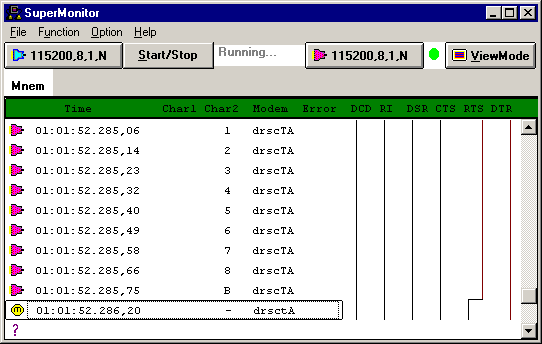|
OnBoard COM1 
it took 0.36ms* = 360 µs (micro seconds) |
|
Serial ports on a PCI card 
it took 0.45ms* = 450 µs (micro seconds) |
The following pictures show some SuperCom specific timings ("direction" switch latency) with the RS-485 controlled through the onboard COM1 and through serial ports on a multiport PCI card.
The data monitor used was capturing data on a Notebook and was not involved in data communications.
The captured data packet was 82 bytes long ("A012345....B").
The last event shows only the RTS signal dropping.
|
OnBoard COM1 
it took 0.36ms* = 360 µs (micro seconds) |
|
Serial ports on a PCI card 
it took 0.45ms* = 450 µs (micro seconds) |
*Direction switch latency was on the above tests constantly less than 1 ms.
The switch latency in SuperCom is also related to the transmission speed (bps). We measured a latency of about 3.50ms when transmitting with 2400 bps, about 1.20ms with 9600bps and below 1 ms when higher than 9600bps. The type of serial port, the number of open serial ports and running on a busy server may have affect on the result.
The serial RS-485 multidrop data communication is mainly used to perform Master to Clients data communication - a network of up to 32 points connected through serial ports. The RS-485 multidop support, in SuperCom, is easily activated by setting the ComType or by a function call.
The RS-485 data communication is some times combined with 9-bit framing. That is something also supported by the SuperCom serial library, even a standard PC UART does not support 9-bit. 9-bit data frames do function with RS-232 also.
NOTE
The above speed tests were performed using Desktop PCs with AMD Athlon 64 X2 2.5GHz and Windows XP. Newer AMD or Intel CPUs are expected to perform 2-10 times faster.
The DEMO software found online, even when activating RS-485, are working with limited functionality, especially when it comes to response timing. The complete functionality, incl. the high speed functions, is contained only in the licensed version.
|
Home Modified at: |

|